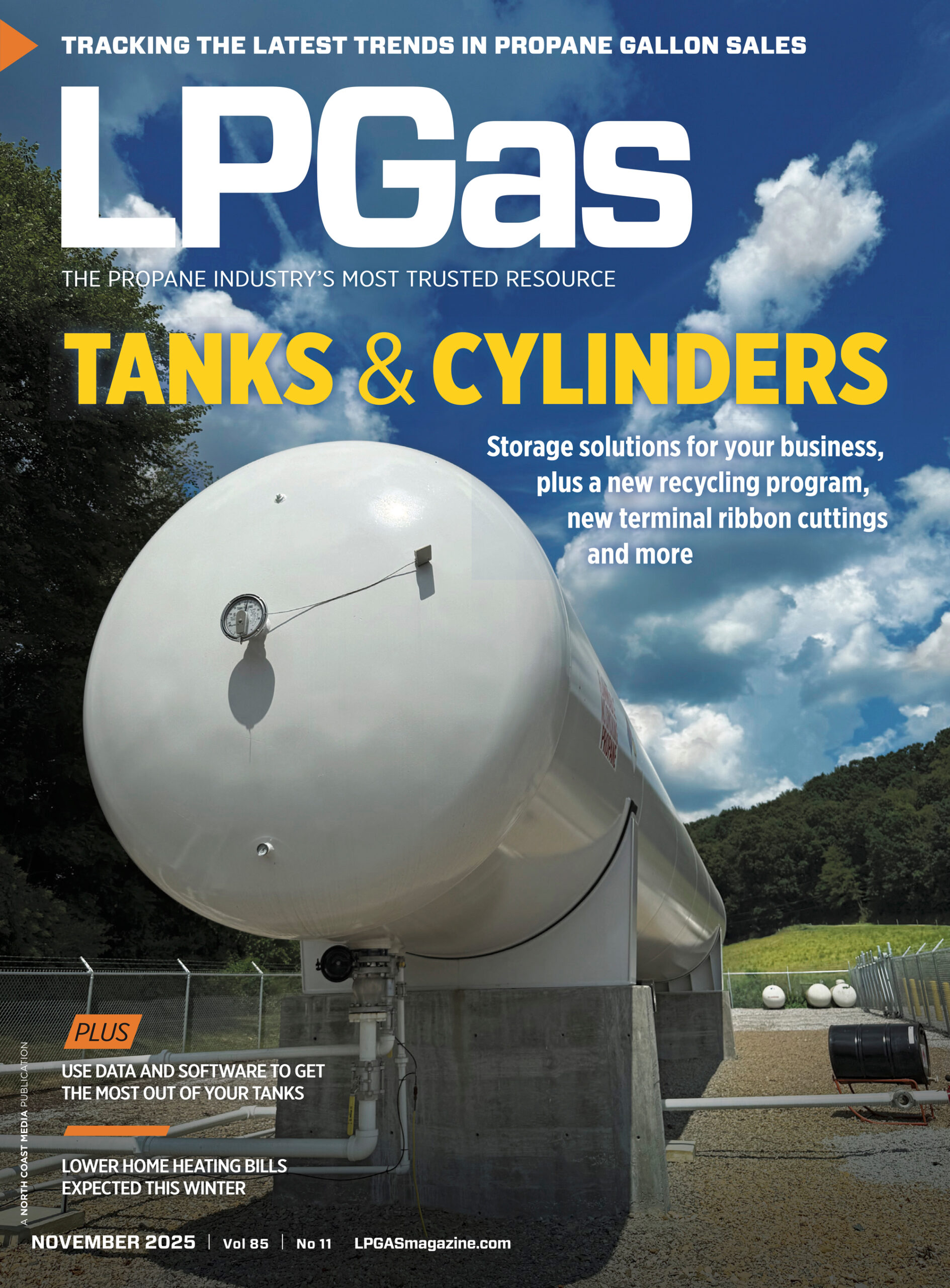US territory sparks global interest in propane-generated electricity
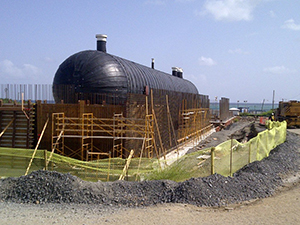
Propane storage tanks on the islands are mounded, encased by multiple layers of earth, sand, rock and gravel to maximize safety. Photo courtesy of the Virgin Islands Water and Power Authority
Residents of the U.S. Virgin Islands received a welcome Christmas gift when the territory’s Water and Power Authority (WAPA) announced that the new year would ring in reduced electricity bills based in part on a switchover from No. 2 fuel oil to propane as the primary power-generating source.
With rates falling from 48.6 cents per kilowatt-hour to 39.19 cents, Hugo V. Hodge Jr., WAPA executive director, says this is only the beginning. He says he looks forward to further rate decreases as the propane conversion project is implemented.
“Delivering affordable and reliable power to our customers throughout the territory remains our top priority, and this rate reduction exemplifies why WAPA has spearheaded the fuel-switch project,” Hodge says.
Vitol wins contract
In July of 2013, a competitive bidding process resulted in a turnkey contract being signed with Vitol Virgin Islands Corp. to construct the infrastructure needed to handle and store the propane.
Vitol has also been converting seven General Electric turbines to burn LP gas along with the existing No. 2 fuel oil. In addition, the turbines are capable of using natural gas if it becomes a more attractive fuel in the future.
Initially estimated to cost $87 million, the project’s price has since risen to $150 million.
Hodge says the primary reasons for the cost increase include improvements in the scope of the project, higher fees for permitting and paying for extra materials needed to complete the endeavor.
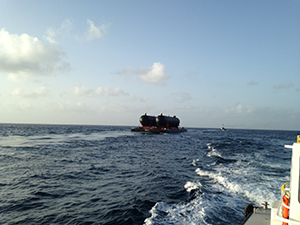
The project involves transporting the propane tanks by barge to locations at St. Croix and St. Thomas. Photo courtesy of the Virgin Islands Water and Power Authority
“For example, the offshore propane storage vessel will now be held in place using a permanent mooring instead of being anchored in place,” he says. “This is a safer and more secure way to keep the fuel in place during periods of inclement weather. Another driver of the cost increase was undocumented soil conditions and underground obstacles at the St. Croix site. On St. Thomas, the volume of rock needed to be removed from the site was far greater than anticipated. Weather-related delays, maintenance and cleanup after storms have also impacted the project budget.”
However, Hodge emphasizes that the adjusted project budget will not influence the amount of savings expected for WAPA customers or the improvements to air quality that the conversion project will deliver for the territory. Hodge says he anticipates a 30 percent reduction in the cost of fuel and a 20 percent reduction in greenhouse gas emissions. While the amortization period will be longer, he adds that the economic environmental benefits will not be forfeited.
The propane project is slated for completion by this spring or summer.
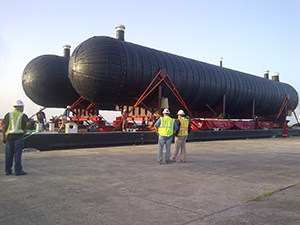
Eight tanks with a total capacity of 65,500 barrels will be located on St. Croix, and 10 tanks with a collective content of 88,000 barrels will be positioned on St. Thomas. Photo courtesy of the Virgin Islands Water and Power Authority
“Vitol is still paying all upfront costs and WAPA will now repay Vitol according to a new amortization schedule,” Hodge says. “WAPA and Vitol had previously agreed to an amortization period of seven years with the option to complete payment in five years. The amortization period has been extended to 10 years with the option to complete payment in seven years.”
“This is a phenomenal deal for the Virgin Islands,” former Gov. John de Jongh says. “The increasing price of fuel oil has been the main driver of utility rate increases for more than a decade and propane is the best near-term option to significantly reduce the cost of fuel for power generation in the territory.”
He adds that the current spurt of lower oil prices has little impact on the conversion program.
“This project will finally free electricity and water customers from the burden of having to pay higher utility bills every time the market price of oil increases,” de Jongh says. “And over the long term, this project will ensure that WAPA will be able to generate electricity from a variety of sources, so the Virgin Islands is no longer tied to just one fuel.”
In addition to being significantly cheaper than oil, propane is one of the cleanest-burning fossil fuels, de Jongh says, making it an attractive option for the U.S. Virgin Islands.
“Carbon dioxide emissions of propane are 20 percent lower than that of fuel oil and 50 percent lower than coal,” he says. “Propane is also nontoxic, so it does not pose any risk to soil or water. Plus, propane helps improve the quality of indoor and outdoor air as it produces less particulate matter and [nitrogen oxides] than diesel, oil or coal.”
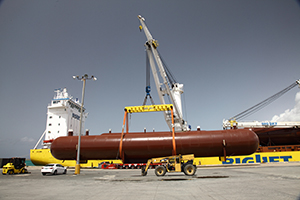
Propane tanks used in the project were manufactured by Belgium-based Geldof Integrated Steel Solutions and brought to a container port at St. Croix. Photo courtesy of the Virgin Islands Water and Power Authority
Tank locations
Expected to annually consume 250,000 tons of propane, the facilities will include eight tanks on St. Croix, with a total capacity of 65,500 barrels storing an effective propane supply of 19.2 days. Ten tanks with a collective content of 88,000 barrels ensuring an effective supply lasting 18.3 days will be positioned on St. Thomas.
All of the storage tanks will be mounded, encased by multiple layers of earth, sand, rock and gravel to maximize safety. The system forms a protective barrier from external damage and fire while eliminating oxygen to prevent uncontrolled ignition. The mounding also provides protection from earthquakes and hurricanes.
Ocean-going ships will deliver the propane from the U.S. Gulf Coast or other supply sources to a large vessel moored in territorial waters. From there, the propane will be transferred to two new tanker ships, the Epic Curacao and Epic Caledonia, which will fill the storage tanks on St. Croix and St. Thomas.
Hodge says the high cost of energy has been one of the biggest challenges for residents and businesses in the U.S. Virgin Islands.
When WAPA executives and senior government officials began researching the prospect of using alternative fuels, they reviewed several options, especially natural gas, “but in the interim noticed an alternate fuel, propane, whose price became advantageous,” he says.
Vitol and an undisclosed amount of other bidders vied for the contract.
“From these proposals, WAPA selected Vitol’s project concept as the most competitive and achievable in the short term,” Hodge says.
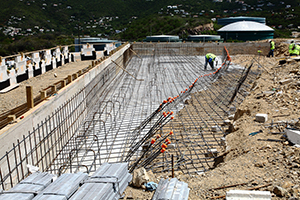
Workers ready the project site at St. Thomas, where 10 propane tanks will be installed for power generation. Photo courtesy of the Virgin Islands Water and Power Authority
A Caribbean model
The United States purchased the group of islands – previously known as the Danish West Indies – from Denmark for $25 million in gold ($580 million in modern-day dollars) as World War I began; American authorities were concerned that the Germans would use the islands for U-boat bases.
The islands, with a land area of 134 square miles, have a population of 106,000 people. English is the official language, and residents of the “organized, unincorporated United States territory” are U.S. citizens. They are not allowed to vote in presidential elections, although they can elect delegates to attend the Democratic and Republican national conventions. The territory has a representative in Congress who can vote in committee meetings but not in floor votes. Tourism, rum production and farming are the main industries.
Larry Osgood, the president of Consulting Solutions who spoke about the propane conversion at the World LP Gas Forum, views the Virgin Islands project as an example of what the propane industry can accomplish in future applications.
“It’s a great demonstration that shows how doable propane power generation is,” he says. “We’re not talking about putting large LPG power generation around the world, but for small and medium operations, it’s great.”
Smaller towns, islands, resorts, guest ranches and conference centers are just a few of the possibilities ripe for implementing propane-generated electricity, according to Osgood.
“Look at operations where electricity is expensive and LPG is available. You can lower their costs and ‘green’ them up,” he says.
Osgood reports that several rum distillers throughout the Caribbean “have used LPG for years” while keeping a lid on propane’s presence for competitive reasons.
“They save a lot of money by using LPG instead of fuel oil, so they don’t like to publicize it,” he says.
The WAPA conversion is especially significant given the territory’s leadership in pursuing the project.
“The biggest thing here is that they’re actually doing something,” Osgood says. “They did it in 18 months, while all the others [who may be considering a switchover] are still talking and having meetings.”
WAPA’s LP gas project has become a model for the Caribbean region. For most Caribbean islands, converting to the use of propane as the primary fuel source for power generation represents the best option to reduce the cost of fuel for power generation while ensuring widespread economic benefits, Hodge comments.
“We have received numerous inquiries and requests for information on our approach and progress regarding this conversion process, which has taken on a life of its own,” Hodge adds. “The entire region is looking at WAPA’s project intently to see how the model can be adapted in their respective areas.”














